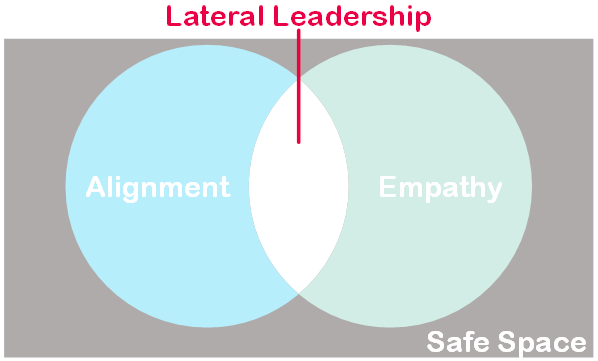Remember the time you had to work in a little group, in school maybe, or within your sports team. Often, there was a natural way of dividing the roles within the team, even if no-one spoke about it, it just happened. One person would take the lead, the others would follow. One person or maybe two people would be the decision makers, the others would execute.
Still in everyday life today, in your work, sports teams, friend groups and travel buddies, you will see the phenomenon coming back. People will automatically follow one person without asking. Having that role within a team is powerful as you can lead the team in the direction of your goal, but also delicate as it easily happens that the role will switch to another leader.
«Lateral leadership is leading without the right of command.»
Go Beyond
We might be wondering the same. What to do to become that leading person and how to achieve the right level of lateral leadership?
To answer this question, I’m talking to executive consultant Thomas Haas. He has been working in the business development and agile consultancy business for years and provides me with new insights in the world of Lateral Leadership.
TH: Currently, many organizations work with a flattened hierarchy, with cross-functional and agile teams. Especially in these self-organising teams, where people don’t have specific titles or job descriptions, leading without authority becomes more important to increase efficiency and to still reach our goals. That is, not only the goals of the organization, but you as a professional and leader want to reach your own goals as well. For our goals to be reached, we need to influence the people around us, align with them on the goal and all act with that goal in mind. For lateral leadership to happen, everyone must voluntarily assume their role and responsibilities and for this to happen there must be trust.
Trust, a commonly used word, and we all know that it’s hard to build up and easy to break. But what does trust actually mean and how can we build trust within these flat organisational structures?
Trust is the believe that someone is good and honest and
will not harm you, or that something is safe and reliable.
Establishing trust is created by making people feel safe and giving them the base of reliability and the belief that what you as a leader say is true and positive. However, the level of safety that is needed for trust and reliability is different for every person.
In order to create the safe space where trust is built on, there are two main ingredients:
Empathy: we want to be seen as a person rather than just as a resource
Alignment: we need to know what the common goal is and we need a stable and continuous way of following the path we have chosen

As lateral leader, it is your role to establish this feeling of empathy and alignment. Hear what your people are saying, explain the why of your actions, align on goals and values and thereby gain the feeling of safety, and thereby trust, of your followers.
Safety is enabled by the organisation
Asking Thomas if he and why he would agree or disagree with this statement, he answered: First of all, establishing trust within the whole organization is key. There needs to be a high level of trust in the company, its values and the management. This starts and ends with trust in the senior management of your company to have the best interest in its employees and the world around us. Important there is to have clear norms and values and continuously follow up on them. Even in times of crisis as we are experiencing now, these values should still stand and you should communicate about them clearly and openly.
This made me think. Do you actually know what the level of trust within your organization is?
Safety is created by the humans within organisations
The overall trust within the organization is needed for managers and leaders to fulfill their role successfully. If there is a lack of continuity and reliability within the organization, how can managers and leaders build up that trust within their team?
So, we see that trust of the employees towards the manager and senior management is important, but what about the other side? Trust from the management towards their employees is just as important. Just relying on your title for people to follow you, is not of this century anymore. Instead, give your employees responsibility to grow their confidence, focus on the output rather than the hours they are spending to fill a seat in the office, and information about the company or business processes to make them see the bigger picture. Read more about establishing trust in the remote working space specifically in this article.
Trusting your employees results in them trusting you.
Thomas: I successfully built my own teams by giving them trust. This allows my colleagues and coworkers to be successful in their own way, to grow and to bring their maximum value and strengths to the team. I’d like to inspire and help others do the same and therefore I am helping executives to build safety and trust within their organization and leadership. To establish trust and safety, it is important to focus on leading both yourself and others, taking responsibility, connecting people and creating the right structures for the team. This is what we teach and practice in our training.
And I fully agree with him, because with every impactful leader taking responsibility for creating alignment and empathy within their team, we are increasing the power and effectiveness of our teams.
So, don’t wait until someone else takes the lead and start today!
You’d like to become a Lateral Leader? Have a look at our Lateral Leadership Training.

